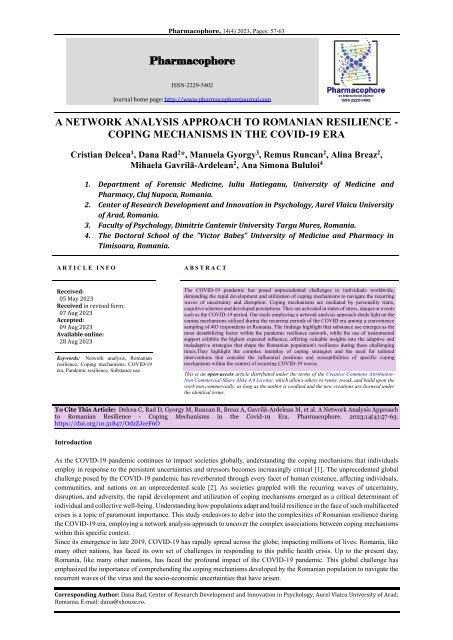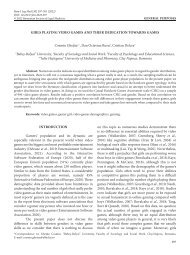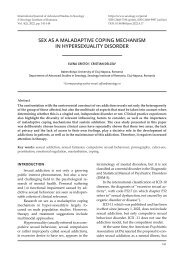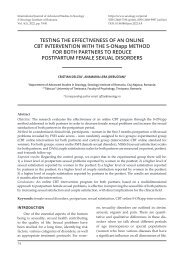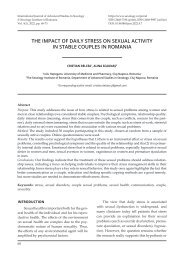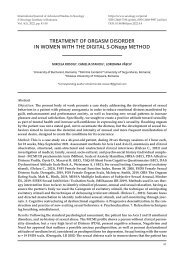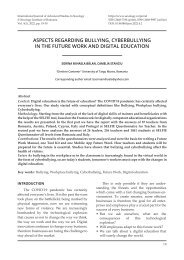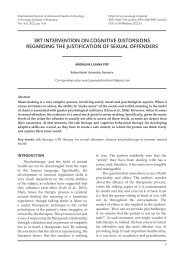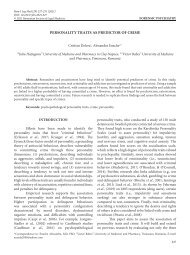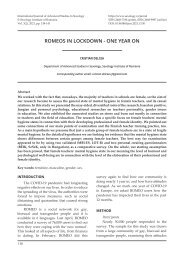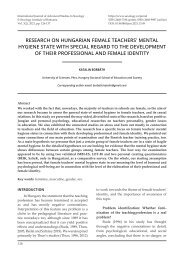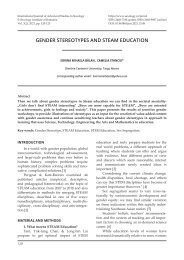A Network Analysis Approach to Romanian Resilience - Coping Mechanisms in the Covid-19 Era
The COVID-19 pandemic has posed unprecedented challenges to individuals worldwide, demanding the rapid development and utilization of coping mechanisms to navigate the recurring waves of uncertainty and disruption. Coping mechanisms are mediated by personality traits, cognitive schemes and developed perceptions. They are activated in states of stress, danger or events such as the COVID-19 period. Our study employing a network analysis approach sheds light on the coping mechanisms utilized during the recurring periods of the COVID era among a convenience sampling of 403 respondents in Romania. The findings highlight that substance use emerges as the most destabilizing factor within the pandemic resilience network, while the use of instrumental support exhibits the highest expected influence, offering valuable insights into the adaptive and maladaptive strategies that shape the Romanian population's resilience during these challenging times.They highlight the complex interplay of coping strategies and the need for tailored interventions that consider the influential positions and susceptibilities of specific coping mechanisms within the context of recurring COVID-19 waves.
The COVID-19 pandemic has posed unprecedented challenges to individuals worldwide, demanding the rapid development and utilization of coping mechanisms to navigate the recurring waves of uncertainty and disruption. Coping mechanisms are mediated by personality traits, cognitive schemes and developed perceptions. They are activated in states of stress, danger or events such as the COVID-19 period. Our study employing a network analysis approach sheds light on the coping mechanisms utilized during the recurring periods of the COVID era among a convenience sampling of 403 respondents in Romania. The findings highlight that substance use emerges as the most destabilizing factor within the pandemic resilience network, while the use of instrumental support exhibits the highest expected influence, offering valuable insights into the adaptive and maladaptive strategies that shape the Romanian population's resilience during these challenging times.They highlight the complex interplay of coping strategies and the need for tailored interventions that consider the influential positions and susceptibilities of specific coping mechanisms within the context of recurring COVID-19 waves.
Create successful ePaper yourself
Turn your PDF publications into a flip-book with our unique Google optimized e-Paper software.
Pharmacophore, 14(4) 2023, Pages: 57-63<br />
Pharmacophore<br />
ISSN-2229-5402<br />
Journal home page: http://www.pharmacophorejournal.com<br />
A NETWORK ANALYSIS APPROACH TO ROMANIAN RESILIENCE -<br />
COPING MECHANISMS IN THE COVID-<strong>19</strong> ERA<br />
Cristian Delcea 1 , Dana Rad 2 *, Manuela Gyorgy 3 , Remus Runcan 2 , Al<strong>in</strong>a Breaz 2 ,<br />
Mihaela Gavrilă-Ardelean 2 , Ana Simona Bululoi 4<br />
1. Department of Forensic Medic<strong>in</strong>e, Iuliu Hatieganu, University of Medic<strong>in</strong>e and<br />
Pharmacy, Cluj Napoca, Romania.<br />
2. Center of Research Development and Innovation <strong>in</strong> Psychology, Aurel Vlaicu University<br />
of Arad, Romania.<br />
3. Faculty of Psychology, Dimitrie Cantemir University Targu Mures, Romania.<br />
4. The Doc<strong>to</strong>ral School of <strong>the</strong> "Vic<strong>to</strong>r Babeş" University of Medic<strong>in</strong>e and Pharmacy <strong>in</strong><br />
Timisoara, Romania.<br />
A R T I C L E I N F O<br />
A B S T R A C T<br />
Received:<br />
05 May 2023<br />
Received <strong>in</strong> revised form:<br />
07 Aug 2023<br />
Accepted:<br />
09 Aug 2023<br />
Available onl<strong>in</strong>e:<br />
28 Aug 2023<br />
Keywords: <strong>Network</strong> analysis, <strong>Romanian</strong><br />
resilience, <strong>Cop<strong>in</strong>g</strong> mechanisms, COVID-<strong>19</strong><br />
era, Pandemic resilience, Substance use<br />
The COVID-<strong>19</strong> pandemic has posed unprecedented challenges <strong>to</strong> <strong>in</strong>dividuals worldwide,<br />
demand<strong>in</strong>g <strong>the</strong> rapid development and utilization of cop<strong>in</strong>g mechanisms <strong>to</strong> navigate <strong>the</strong> recurr<strong>in</strong>g<br />
waves of uncerta<strong>in</strong>ty and disruption. <strong>Cop<strong>in</strong>g</strong> mechanisms are mediated by personality traits,<br />
cognitive schemes and developed perceptions. They are activated <strong>in</strong> states of stress, danger or events<br />
such as <strong>the</strong> COVID-<strong>19</strong> period. Our study employ<strong>in</strong>g a network analysis approach sheds light on <strong>the</strong><br />
cop<strong>in</strong>g mechanisms utilized dur<strong>in</strong>g <strong>the</strong> recurr<strong>in</strong>g periods of <strong>the</strong> COVID era among a convenience<br />
sampl<strong>in</strong>g of 403 respondents <strong>in</strong> Romania. The f<strong>in</strong>d<strong>in</strong>gs highlight that substance use emerges as <strong>the</strong><br />
most destabiliz<strong>in</strong>g fac<strong>to</strong>r with<strong>in</strong> <strong>the</strong> pandemic resilience network, while <strong>the</strong> use of <strong>in</strong>strumental<br />
support exhibits <strong>the</strong> highest expected <strong>in</strong>fluence, offer<strong>in</strong>g valuable <strong>in</strong>sights <strong>in</strong><strong>to</strong> <strong>the</strong> adaptive and<br />
maladaptive strategies that shape <strong>the</strong> <strong>Romanian</strong> population's resilience dur<strong>in</strong>g <strong>the</strong>se challeng<strong>in</strong>g<br />
times.They highlight <strong>the</strong> complex <strong>in</strong>terplay of cop<strong>in</strong>g strategies and <strong>the</strong> need for tailored<br />
<strong>in</strong>terventions that consider <strong>the</strong> <strong>in</strong>fluential positions and susceptibilities of specific cop<strong>in</strong>g<br />
mechanisms with<strong>in</strong> <strong>the</strong> context of recurr<strong>in</strong>g COVID-<strong>19</strong> waves.<br />
This is an open-access article distributed under <strong>the</strong> terms of <strong>the</strong> Creative Commons Attribution-<br />
Non Commercial-Share Alike 4.0 License, which allows o<strong>the</strong>rs <strong>to</strong> remix, tweak, and build upon <strong>the</strong><br />
work non commercially, as long as <strong>the</strong> author is credited and <strong>the</strong> new creations are licensed under<br />
<strong>the</strong> identical terms.<br />
To Cite This Article: Delcea C, Rad D, Gyorgy M, Runcan R, Breaz A, Gavrilă-Ardelean M, et al. A <strong>Network</strong> <strong>Analysis</strong> <strong>Approach</strong><br />
<strong>to</strong> <strong>Romanian</strong> <strong>Resilience</strong> - <strong>Cop<strong>in</strong>g</strong> <strong>Mechanisms</strong> <strong>in</strong> <strong>the</strong> <strong>Covid</strong>-<strong>19</strong> <strong>Era</strong>. Pharmacophore. 2023;14(4):57-63.<br />
https://doi.org/10.51847/OdzZJceF6O<br />
Introduction<br />
As <strong>the</strong> COVID-<strong>19</strong> pandemic cont<strong>in</strong>ues <strong>to</strong> impact societies globally, understand<strong>in</strong>g <strong>the</strong> cop<strong>in</strong>g mechanisms that <strong>in</strong>dividuals<br />
employ <strong>in</strong> response <strong>to</strong> <strong>the</strong> persistent uncerta<strong>in</strong>ties and stressors becomes <strong>in</strong>creas<strong>in</strong>gly critical [1]. The unprecedented global<br />
challenge posed by <strong>the</strong> COVID-<strong>19</strong> pandemic has reverberated through every facet of human existence, affect<strong>in</strong>g <strong>in</strong>dividuals,<br />
communities, and nations on an unprecedented scale [2]. As societies grappled with <strong>the</strong> recurr<strong>in</strong>g waves of uncerta<strong>in</strong>ty,<br />
disruption, and adversity, <strong>the</strong> rapid development and utilization of cop<strong>in</strong>g mechanisms emerged as a critical determ<strong>in</strong>ant of<br />
<strong>in</strong>dividual and collective well-be<strong>in</strong>g. Understand<strong>in</strong>g how populations adapt and build resilience <strong>in</strong> <strong>the</strong> face of such multifaceted<br />
crises is a <strong>to</strong>pic of paramount importance. This study endeavors <strong>to</strong> delve <strong>in</strong><strong>to</strong> <strong>the</strong> complexities of <strong>Romanian</strong> resilience dur<strong>in</strong>g<br />
<strong>the</strong> COVID-<strong>19</strong> era, employ<strong>in</strong>g a network analysis approach <strong>to</strong> uncover <strong>the</strong> complex associations between cop<strong>in</strong>g mechanisms<br />
with<strong>in</strong> this specific context.<br />
S<strong>in</strong>ce its emergence <strong>in</strong> late 20<strong>19</strong>, COVID-<strong>19</strong> has rapidly spread across <strong>the</strong> globe, impact<strong>in</strong>g millions of lives. Romania, like<br />
many o<strong>the</strong>r nations, has faced its own set of challenges <strong>in</strong> respond<strong>in</strong>g <strong>to</strong> this public health crisis. Up <strong>to</strong> <strong>the</strong> present day,<br />
Romania, like many o<strong>the</strong>r nations, has faced <strong>the</strong> profound impact of <strong>the</strong> COVID-<strong>19</strong> pandemic. This global challenge has<br />
emphasized <strong>the</strong> importance of comprehend<strong>in</strong>g <strong>the</strong> cop<strong>in</strong>g mechanisms developed by <strong>the</strong> <strong>Romanian</strong> population <strong>to</strong> navigate <strong>the</strong><br />
recurrent waves of <strong>the</strong> virus and <strong>the</strong> socio-economic uncerta<strong>in</strong>ties that have arisen.<br />
Correspond<strong>in</strong>g Author: Dana Rad, Center of Research Development and Innovation <strong>in</strong> Psychology, Aurel Vlaicu University of Arad,<br />
Romania. E-mail: dana@xhouse.ro.
Delcea et al., 2023<br />
Pharmacophore, 14(4) 2023, Pages 57-63<br />
<strong>Resilience</strong>, a concept rooted <strong>in</strong> psychology and sociology, encapsulates an <strong>in</strong>dividual's or a community's ability <strong>to</strong> adapt and<br />
bounce back <strong>in</strong> <strong>the</strong> face of adversity [3]. It <strong>in</strong>volves a dynamic <strong>in</strong>terplay between various fac<strong>to</strong>rs, <strong>in</strong>clud<strong>in</strong>g <strong>in</strong>dividual<br />
psychological characteristics, social support systems, and <strong>the</strong> environment [4]. In <strong>the</strong> context of <strong>the</strong> COVID-<strong>19</strong> pandemic,<br />
resilience becomes a lens through which we can understand how <strong>in</strong>dividuals and communities navigate <strong>the</strong> ongo<strong>in</strong>g challenges,<br />
mitigate psychological distress, and thrive despite adverse circumstances.<br />
<strong>Resilience</strong> is not a fixed trait but a dynamic process that <strong>in</strong>dividuals and communities can cultivate and enhance [5]. <strong>Cop<strong>in</strong>g</strong><br />
mechanisms, which encompass a range of psychological and behavioral strategies used <strong>to</strong> manage stressors, play a pivotal role<br />
<strong>in</strong> this process [6]. <strong>Cop<strong>in</strong>g</strong> mechanisms can be adaptive, help<strong>in</strong>g <strong>in</strong>dividuals ma<strong>in</strong>ta<strong>in</strong> emotional well-be<strong>in</strong>g and adapt <strong>to</strong><br />
chang<strong>in</strong>g circumstances, or maladaptive, exacerbat<strong>in</strong>g distress and h<strong>in</strong>der<strong>in</strong>g resilience [7].<br />
The COVID-<strong>19</strong> pandemic has <strong>in</strong>troduced a novel dimension of uncerta<strong>in</strong>ty-social uncerta<strong>in</strong>ty [8], Lockdowns, social<br />
distanc<strong>in</strong>g measures, economic disruptions, and a constantly evolv<strong>in</strong>g public health landscape have led <strong>to</strong> a profound sense of<br />
unpredictability and <strong>in</strong>stability <strong>in</strong> <strong>in</strong>dividuals' lives [9]. This dynamic social uncerta<strong>in</strong>ty poses unique challenges <strong>to</strong> resilience,<br />
as <strong>in</strong>dividuals must navigate not only health-related concerns but also <strong>the</strong> complex <strong>in</strong>terplay of societal and economic fac<strong>to</strong>rs<br />
[10]. Understand<strong>in</strong>g how <strong>in</strong>dividuals <strong>in</strong> Romania have coped with <strong>the</strong>se multifaceted stressors is essential for develop<strong>in</strong>g<br />
targeted <strong>in</strong>terventions and foster<strong>in</strong>g a deeper appreciation of <strong>the</strong> human capacity for adaptation and resilience [11].<br />
In light of <strong>the</strong>se considerations, this transversal study utilizes a network analysis approach <strong>to</strong> unravel <strong>the</strong> cop<strong>in</strong>g mechanisms<br />
that have emerged among <strong>the</strong> <strong>Romanian</strong> population dur<strong>in</strong>g <strong>the</strong> COVID-<strong>19</strong> era. By identify<strong>in</strong>g <strong>the</strong> key fac<strong>to</strong>rs <strong>in</strong>fluenc<strong>in</strong>g<br />
resilience and shedd<strong>in</strong>g light on <strong>the</strong> adaptive and maladaptive strategies adopted, we aim <strong>to</strong> contribute valuable <strong>in</strong>sights <strong>in</strong><strong>to</strong><br />
<strong>the</strong> <strong>in</strong>tricacies of <strong>Romanian</strong> cop<strong>in</strong>g mechanisms <strong>in</strong> <strong>the</strong> face of social uncerta<strong>in</strong>ty imposed by recent COVID-<strong>19</strong>.<br />
Materials and Methods<br />
Instrument<br />
The Brief COPE (<strong>Cop<strong>in</strong>g</strong> Orientation <strong>to</strong> Problems Experienced) questionnaire is a widely used self-report <strong>to</strong>ol designed <strong>to</strong><br />
assess various cop<strong>in</strong>g strategies employed by <strong>in</strong>dividuals <strong>in</strong> response <strong>to</strong> stressors and challeng<strong>in</strong>g situations [12]. This<br />
<strong>in</strong>strument is particularly valuable <strong>in</strong> understand<strong>in</strong>g how <strong>in</strong>dividuals cope with stress, adversity, and life changes. The Brief<br />
COPE questionnaire consists of 28 items that cover 14 different cop<strong>in</strong>g strategies, with two items per strategy. Respondents<br />
are asked <strong>to</strong> rate how often <strong>the</strong>y use each cop<strong>in</strong>g strategy on a scale rang<strong>in</strong>g from "I haven't been do<strong>in</strong>g this at all" (1) <strong>to</strong> "I've<br />
been do<strong>in</strong>g this a lot" (4). The 14 cop<strong>in</strong>g strategies assessed by <strong>the</strong> Brief COPE <strong>in</strong>clude:<br />
• Self-distraction: Engag<strong>in</strong>g <strong>in</strong> activities <strong>to</strong> take one's m<strong>in</strong>d off <strong>the</strong> problem.<br />
• Active cop<strong>in</strong>g: Tak<strong>in</strong>g steps <strong>to</strong> try <strong>to</strong> remove or reduce <strong>the</strong> stressor.<br />
• Denial: Refus<strong>in</strong>g <strong>to</strong> believe that <strong>the</strong> stressor exists.<br />
• Substance use: Us<strong>in</strong>g substances like alcohol or drugs <strong>to</strong> cope.<br />
• Use of emotional support: Seek<strong>in</strong>g emotional support from o<strong>the</strong>rs.<br />
• Use of <strong>in</strong>strumental support: Seek<strong>in</strong>g practical help and advice from o<strong>the</strong>rs.<br />
• Behavioral disengagement: Reduc<strong>in</strong>g one's effort and giv<strong>in</strong>g up.<br />
• Vent<strong>in</strong>g: Express<strong>in</strong>g negative emotions and frustrations.<br />
• Positive refram<strong>in</strong>g: Try<strong>in</strong>g <strong>to</strong> see <strong>the</strong> situation <strong>in</strong> a more positive light.<br />
• Plann<strong>in</strong>g: Creat<strong>in</strong>g a plan of action <strong>to</strong> deal with <strong>the</strong> stressor.<br />
• Humor: F<strong>in</strong>d<strong>in</strong>g humor <strong>in</strong> <strong>the</strong> situation <strong>to</strong> reduce stress.<br />
• Acceptance: Acknowledg<strong>in</strong>g and accept<strong>in</strong>g <strong>the</strong> reality of <strong>the</strong> stressor.<br />
• Religion: Turn<strong>in</strong>g <strong>to</strong> religious or spiritual beliefs for support.<br />
• Self-blame: Criticiz<strong>in</strong>g oneself for <strong>the</strong> situation or blam<strong>in</strong>g oneself for <strong>the</strong> stressor.<br />
The Brief COPE questionnaire provides valuable <strong>in</strong>sights <strong>in</strong><strong>to</strong> an <strong>in</strong>dividual's cop<strong>in</strong>g style and preferences.<br />
In terms of reliability, <strong>the</strong> obta<strong>in</strong>ed Cronbach's Alpha value of 0.844 falls well above <strong>the</strong> commonly accepted threshold of 0.70,<br />
which researchers often use as a benchmark for consider<strong>in</strong>g a scale or questionnaire <strong>to</strong> be reliable [13]. This result affirms <strong>the</strong><br />
reliability of our questionnaire for assess<strong>in</strong>g <strong>the</strong> specific construct of <strong>in</strong>terest. In essence, it underscores that our measurement<br />
<strong>in</strong>strument is well-suited for collect<strong>in</strong>g data related <strong>to</strong> <strong>the</strong> construct under <strong>in</strong>vestigation, <strong>in</strong>still<strong>in</strong>g confidence <strong>in</strong> <strong>the</strong> robustness<br />
of our research f<strong>in</strong>d<strong>in</strong>gs.<br />
Participants<br />
The participants <strong>in</strong> this study were recruited us<strong>in</strong>g a convenience sampl<strong>in</strong>g method, primarily through <strong>the</strong> dissem<strong>in</strong>ation of <strong>the</strong><br />
questionnaire l<strong>in</strong>k across various social media platforms. This approach facilitated <strong>the</strong> engagement of a diverse group of<br />
<strong>in</strong>dividuals who voluntarily chose <strong>to</strong> participate <strong>in</strong> <strong>the</strong> research. A <strong>to</strong>tal of 403 respondents <strong>to</strong>ok part <strong>in</strong> <strong>the</strong> study, compris<strong>in</strong>g<br />
both male and female participants. The gender distribution with<strong>in</strong> <strong>the</strong> sample <strong>in</strong>dicated that approximately 60% of <strong>the</strong><br />
respondents identified as male, while <strong>the</strong> rema<strong>in</strong><strong>in</strong>g 40% identified as female.<br />
Regard<strong>in</strong>g <strong>the</strong> age distribution of <strong>the</strong> participants, <strong>the</strong> data reveals a diverse representation across various age groups. The<br />
majority of respondents fell with<strong>in</strong> <strong>the</strong> age range of 26 <strong>to</strong> 35 years, account<strong>in</strong>g for approximately 32.75% of <strong>the</strong> sample.<br />
58
Valid<br />
Miss<strong>in</strong>g<br />
Mean<br />
Std.<br />
Deviation<br />
Upper<br />
Lower<br />
Shapiro-<br />
Wilk<br />
P-value of<br />
Shapiro-<br />
Wilk<br />
M<strong>in</strong>imum<br />
Maximum<br />
Delcea et al., 2023<br />
Pharmacophore, 14(4) 2023, Pages 57-63<br />
Additionally, <strong>in</strong>dividuals aged 36 <strong>to</strong> 45 years constituted 24.32% of <strong>the</strong> participants, followed by those aged 18 <strong>to</strong> 25 years at<br />
11.41%. Respondents aged 46 <strong>to</strong> 55 years accounted for 3.97% of <strong>the</strong> sample, and participants aged over 56 years represented<br />
2.23% of <strong>the</strong> <strong>to</strong>tal respondents.<br />
It is noteworthy that <strong>the</strong>re were no miss<strong>in</strong>g data po<strong>in</strong>ts <strong>in</strong> <strong>the</strong> age category, <strong>in</strong>dicat<strong>in</strong>g complete responses from all participants.<br />
The diverse age and gender composition of <strong>the</strong> sample enhances <strong>the</strong> generalizability of <strong>the</strong> study's f<strong>in</strong>d<strong>in</strong>gs and provides<br />
valuable <strong>in</strong>sights <strong>in</strong><strong>to</strong> cop<strong>in</strong>g mechanisms across different demographic groups.<br />
Results and Discussion<br />
In Table 1 we provide an overview of <strong>the</strong> descriptive statistics for <strong>the</strong> various cop<strong>in</strong>g strategies as assessed by <strong>the</strong> questionnaire.<br />
These statistics offer <strong>in</strong>sights <strong>in</strong><strong>to</strong> <strong>the</strong> central tendencies and variability of responses among <strong>the</strong> participants. We also <strong>in</strong>clude<br />
95% confidence <strong>in</strong>tervals and measures of variance <strong>to</strong> comprehensively describe <strong>the</strong> data.<br />
Table 1. Descriptive Statistics<br />
95% Confidence Interval Variance<br />
Self-distraction 403 0 5.692 1.416 2.271 1.733 0.938 < .001 2.000 8.000<br />
Active cop<strong>in</strong>g 403 0 5.551 1.524 2.606 2.040 0.943 < .001 2.000 8.000<br />
Denial 403 0 3.367 1.407 2.307 1.674 0.849 < .001 2.000 8.000<br />
Substance use 403 0 2.459 1.005 1.330 0.725 0.508 < .001 2.000 8.000<br />
Use of emotional support 403 0 4.754 1.734 3.317 2.685 0.940 < .001 2.000 8.000<br />
Use of <strong>in</strong>strumental support 403 0 4.380 1.575 2.778 2.172 0.933 < .001 2.000 8.000<br />
Behavioral disengagement 403 0 2.586 1.115 1.566 0.927 0.594 < .001 2.000 8.000<br />
Vent<strong>in</strong>g 403 0 4.129 1.527 2.610 2.035 0.927 < .001 2.000 8.000<br />
Positive refram<strong>in</strong>g 403 0 5.615 1.492 2.502 1.965 0.939 < .001 2.000 8.000<br />
Plann<strong>in</strong>g 403 0 4.501 1.343 2.060 1.546 0.940 < .001 2.000 8.000<br />
Humor 403 0 4.489 1.563 2.731 2.170 0.944 < .001 2.000 8.000<br />
Acceptance 403 0 6.362 1.261 1.802 1.365 0.901 < .001 2.000 8.000<br />
Religion 403 0 5.303 1.916 4.007 3.312 0.921 < .001 2.000 8.000<br />
Self-blame 403 0 2.913 1.205 1.781 1.158 0.750 < .001 2.000 8.000<br />
Participants reported an average score of 5.692 (SD = 1.416) for <strong>the</strong> self-distraction cop<strong>in</strong>g mechanism. The 95% confidence<br />
<strong>in</strong>terval for this strategy ranged from 2.271 <strong>to</strong> 1.733. The Shapiro-Wilk test for normality resulted <strong>in</strong> a statistic of 0.938, with<br />
a significant p-value (< .001), <strong>in</strong>dicat<strong>in</strong>g a deviation from normal distribution. Scores for self-distraction ranged from a<br />
m<strong>in</strong>imum of 2.000 <strong>to</strong> a maximum of 8.000.<br />
For <strong>the</strong> active cop<strong>in</strong>g mechanism, participants had an average score of 5.551 (SD = 1.524). The 95% confidence <strong>in</strong>terval ranged<br />
from 2.606 <strong>to</strong> 2.040. The Shapiro-Wilk test statistic was 0.943, with a significant p-value (< .001), suggest<strong>in</strong>g non-normality<br />
<strong>in</strong> <strong>the</strong> distribution of scores. Responses for active cop<strong>in</strong>g varied between a m<strong>in</strong>imum of 2.000 and a maximum of 8.000.<br />
The denial cop<strong>in</strong>g mechanism yielded an average score of 3.367 (SD = 1.407) among participants. The 95% confidence <strong>in</strong>terval<br />
for this strategy spanned from 2.307 <strong>to</strong> 1.674. The Shapiro-Wilk test <strong>in</strong>dicated non-normality with a statistic of 0.849 and a<br />
significant p-value (< .001). Scores for denial ranged from 2.000 <strong>to</strong> 8.000.<br />
Similarly, for each of <strong>the</strong> rema<strong>in</strong><strong>in</strong>g cop<strong>in</strong>g mechanisms, <strong>the</strong> descriptive statistics provide <strong>in</strong>sights <strong>in</strong><strong>to</strong> <strong>the</strong> participants'<br />
responses, variability, and distribution, allow<strong>in</strong>g for a comprehensive understand<strong>in</strong>g of <strong>the</strong>ir cop<strong>in</strong>g strategies, as depicted <strong>in</strong><br />
Table 1.<br />
Fur<strong>the</strong>r, we have employed a correlation analysis <strong>to</strong> comprehend <strong>the</strong> <strong>in</strong>terrelationships between <strong>the</strong>se cop<strong>in</strong>g mechanisms. This<br />
approach allows us <strong>to</strong> <strong>in</strong>vestigate how different strategies may be associated with each o<strong>the</strong>r and whe<strong>the</strong>r <strong>the</strong>y exhibit patterns<br />
of positive or negative correlation. Such <strong>in</strong>sights enable us <strong>to</strong> explore whe<strong>the</strong>r <strong>in</strong>dividuals tend <strong>to</strong> employ multiple cop<strong>in</strong>g<br />
mechanisms simultaneously or whe<strong>the</strong>r certa<strong>in</strong> strategies are mutually exclusive.<br />
Our correlation analysis facilitates a deeper understand<strong>in</strong>g of <strong>the</strong> cop<strong>in</strong>g strategies utilized by our study participants dur<strong>in</strong>g <strong>the</strong><br />
recurr<strong>in</strong>g challenges posed by <strong>the</strong> <strong>Covid</strong> era. By exam<strong>in</strong><strong>in</strong>g <strong>the</strong> relationships between <strong>the</strong>se strategies, we aim <strong>to</strong> uncover<br />
potential clusters of cop<strong>in</strong>g mechanisms and identify whe<strong>the</strong>r specific patterns emerge with<strong>in</strong> our sample. The correlation<br />
matrix is visually presented <strong>in</strong> Figure 1.<br />
59
Delcea et al., 2023<br />
Pharmacophore, 14(4) 2023, Pages 57-63<br />
Figure 1. Correlations heatmap between cop<strong>in</strong>g mechanisms<br />
Pearson's correlations were employed <strong>to</strong> exam<strong>in</strong>e <strong>the</strong> associations between various cop<strong>in</strong>g mechanisms. Active cop<strong>in</strong>g<br />
exhibited a robust positive correlation with plann<strong>in</strong>g (r = 0.492) and use of <strong>in</strong>strumental support (r = 0.348). Positive refram<strong>in</strong>g<br />
also showed strong positive correlations with plann<strong>in</strong>g (r = 0.358) and active cop<strong>in</strong>g (r = 0.380). Vent<strong>in</strong>g displayed a strong<br />
positive correlation with <strong>the</strong> use of <strong>in</strong>strumental support (r = 0.355) and active cop<strong>in</strong>g (r = 0.252). Fur<strong>the</strong>rmore, <strong>the</strong> use of<br />
emotional support displayed a strong positive correlation with <strong>the</strong> use of <strong>in</strong>strumental support (r = 0.617). Self-distraction<br />
demonstrated moderate positive correlations with active cop<strong>in</strong>g (r = 0.463) and positive refram<strong>in</strong>g (r = 0.427). The use of<br />
emotional support exhibited moderate positive correlations with plann<strong>in</strong>g (r = 0.382) and positive refram<strong>in</strong>g (r = 0.311).<br />
Acceptance was negatively correlated with denial (r = -0.114) and substance use (r = -0.071). Several cop<strong>in</strong>g mechanisms,<br />
such as substance use, humor, and religion, displayed weak correlations with many o<strong>the</strong>r cop<strong>in</strong>g mechanisms.<br />
Correlation analysis and network analysis are two powerful techniques used <strong>in</strong> <strong>the</strong> field of data analysis, particularly <strong>in</strong><br />
psychology, social sciences, and various o<strong>the</strong>r doma<strong>in</strong>s [14]. They are <strong>in</strong>terconnected and often complement each o<strong>the</strong>r,<br />
mak<strong>in</strong>g <strong>the</strong>ir comb<strong>in</strong>ed use essential for ga<strong>in</strong><strong>in</strong>g a comprehensive understand<strong>in</strong>g of complex systems. Correlation analysis is<br />
primarily focused on measur<strong>in</strong>g <strong>the</strong> strength and direction of relationships between variables. It helps identify which variables<br />
are associated with each o<strong>the</strong>r and <strong>the</strong> nature of those associations (positive, negative, or none) [14]. However, correlation<br />
analysis provides a limited view of <strong>the</strong> overall structure of relationships with<strong>in</strong> a dataset. <strong>Network</strong> analysis, on <strong>the</strong> o<strong>the</strong>r hand,<br />
takes correlation analysis <strong>to</strong> <strong>the</strong> next level by visualiz<strong>in</strong>g and quantify<strong>in</strong>g <strong>the</strong> <strong>in</strong>tricate network of connections among variables.<br />
Instead of exam<strong>in</strong><strong>in</strong>g pairwise correlations <strong>in</strong> isolation, network analysis constructs a network or graph where each variable is<br />
a node, and <strong>the</strong> edges represent <strong>the</strong> relationships between <strong>the</strong>m [14]. This approach uncovers <strong>the</strong> complex structures and<br />
dependencies that might be overlooked <strong>in</strong> traditional correlation matrices. <strong>Network</strong> analysis also helps identify central nodes<br />
(variables) <strong>in</strong> <strong>the</strong> network that play crucial roles <strong>in</strong> <strong>in</strong>fluenc<strong>in</strong>g o<strong>the</strong>r nodes. These central nodes are often referred <strong>to</strong> as "hubs"<br />
and are essential for understand<strong>in</strong>g <strong>the</strong> flow of <strong>in</strong>formation, <strong>in</strong>fluence, or <strong>in</strong>teractions with<strong>in</strong> a system [15]. Correlation analysis<br />
alone cannot provide this level of <strong>in</strong>sight <strong>in</strong><strong>to</strong> centrality. In situations where <strong>the</strong>re are numerous variables <strong>to</strong> consider<br />
60
Delcea et al., 2023<br />
Pharmacophore, 14(4) 2023, Pages 57-63<br />
simultaneously, network analysis is particularly advantageous. It can handle high-dimensional data by represent<strong>in</strong>g <strong>the</strong><br />
relationships <strong>in</strong> a visually <strong>in</strong>terpretable format, mak<strong>in</strong>g it easier <strong>to</strong> discern patterns and <strong>in</strong>teractions [16], as <strong>in</strong> our case.<br />
We have fur<strong>the</strong>r employed a network analysis <strong>in</strong> JASP software. Results show that <strong>the</strong> structure of <strong>the</strong> network <strong>in</strong>dicates that<br />
<strong>the</strong>re are 14 nodes (14 cop<strong>in</strong>g mechanisms), and 66 edges (connections) exist among <strong>the</strong>m. The sparsity of <strong>the</strong> network<br />
coefficient is 0.275, <strong>in</strong>dicat<strong>in</strong>g that <strong>the</strong> network is not densely connected, suggest<strong>in</strong>g some level of <strong>in</strong>dependence or separation<br />
among variables.<br />
Figure 2. <strong>Network</strong> analysis results for <strong>the</strong> cop<strong>in</strong>g mechanisms<br />
The network analysis presented <strong>in</strong> Figure 2 offers a visual and quantitative representation of <strong>the</strong> relationships among variables,<br />
shedd<strong>in</strong>g light on <strong>the</strong> complex relationships with<strong>in</strong> <strong>the</strong> cop<strong>in</strong>g mechanisms.<br />
The centrality measures per variable coefficients provide a quantitative perspective on <strong>the</strong> centrality measures.<br />
Table 2. Centrality measures per variable<br />
<strong>Network</strong><br />
Variable Betweenness Closeness Strength Expected <strong>in</strong>fluence<br />
Self-distraction -0.298 -0.666 -0.438 0.350<br />
Active cop<strong>in</strong>g -0.298 -1.<strong>19</strong>3 0.407 0.296<br />
Denial -1.033 -0.739 -0.676 -0.642<br />
Substance use -0.788 -0.108 -1.605 -1.618<br />
Use of emotional support -1.033 -1.421 -1.497 0.126<br />
Use of <strong>in</strong>strumental support 1.173 0.137 0.978 1.807<br />
Behavioral disengagement 1.418 1.244 0.852 -0.630<br />
Vent<strong>in</strong>g -1.033 0.100 -0.517 0.983<br />
Positive refram<strong>in</strong>g -0.543 -0.239 1.210 0.937<br />
Plann<strong>in</strong>g 0.438 -0.625 -0.683 0.892<br />
Humor -1.033 -0.638 -0.731 -1.026<br />
Acceptance 0.<strong>19</strong>3 0.875 1.488 -1.096<br />
Religion 1.418 1.599 0.543 -0.937<br />
Self-blame 1.418 1.674 0.669 0.558<br />
The network analysis results presented <strong>in</strong> Table 2 provide valuable <strong>in</strong>sights <strong>in</strong><strong>to</strong> <strong>the</strong> centrality measures of each variable with<strong>in</strong><br />
<strong>the</strong> studied network. These centrality measures offer a deeper understand<strong>in</strong>g of <strong>the</strong> roles and importance of <strong>in</strong>dividual variables<br />
<strong>in</strong> <strong>the</strong> context of <strong>the</strong> larger network structure.<br />
Betweenness centrality measures <strong>the</strong> extent <strong>to</strong> which a variable acts as a bridge or <strong>in</strong>termediary between o<strong>the</strong>r variables <strong>in</strong> <strong>the</strong><br />
network. Variables with higher betweenness values, such as "Behavioral Disengagement" (1.418), "Religion" (1.418), and<br />
"Self-Blame" (1.418), exhibit notably high betweenness centrality values, suggest<strong>in</strong>g that <strong>the</strong>y serve as key bridges <strong>in</strong> <strong>the</strong> flow<br />
of <strong>in</strong>formation or <strong>in</strong>fluence with<strong>in</strong> <strong>the</strong> network.<br />
Closeness centrality assesses how quickly a variable can access all o<strong>the</strong>r variables <strong>in</strong> <strong>the</strong> network. Variables with higher<br />
closeness values are more central and have shorter average distances <strong>to</strong> o<strong>the</strong>r variables. In this analysis, "Active <strong>Cop<strong>in</strong>g</strong>" (-<br />
1.<strong>19</strong>3) demonstrates <strong>the</strong> highest negative closeness centrality, <strong>in</strong>dicat<strong>in</strong>g that it is relatively less central <strong>in</strong> terms of accessibility<br />
<strong>to</strong> o<strong>the</strong>r variables. Conversely, "Self-Blame" (1.674) exhibits <strong>the</strong> highest positive closeness centrality, signify<strong>in</strong>g its central<br />
position and ease of access with<strong>in</strong> <strong>the</strong> network.<br />
61
Delcea et al., 2023<br />
Pharmacophore, 14(4) 2023, Pages 57-63<br />
Strength centrality quantifies <strong>the</strong> overall <strong>in</strong>fluence of a variable based on <strong>the</strong> sum of its connection strengths with o<strong>the</strong>r<br />
variables. High-strength variables are <strong>in</strong>fluential and have strong direct connections with o<strong>the</strong>r variables. In this analysis,<br />
"Acceptance" (1.488) and "Use of Instrumental Support" (0.978) emerge as <strong>the</strong> highest-strength variables, imply<strong>in</strong>g that <strong>the</strong>y<br />
have a substantial direct <strong>in</strong>fluence on o<strong>the</strong>r variables with<strong>in</strong> <strong>the</strong> network. Conversely, "Substance Use" (-1.605) shows <strong>the</strong><br />
highest negative strength centrality, suggest<strong>in</strong>g a weaker <strong>in</strong>fluence compared <strong>to</strong> o<strong>the</strong>rs.<br />
Expected <strong>in</strong>fluence represents <strong>the</strong> expected impact of a variable with<strong>in</strong> <strong>the</strong> network, consider<strong>in</strong>g its structural position and<br />
connections [17]. Positive values <strong>in</strong>dicate variables expected <strong>to</strong> exert <strong>in</strong>fluence, while negative values suggest variables<br />
expected <strong>to</strong> be <strong>in</strong>fluenced by o<strong>the</strong>rs. "Use of Instrumental Support" (1.807) stands out with <strong>the</strong> highest positive expected<br />
<strong>in</strong>fluence, <strong>in</strong>dicat<strong>in</strong>g its potential <strong>to</strong> <strong>in</strong>fluence o<strong>the</strong>r variables positively. On <strong>the</strong> o<strong>the</strong>r hand, "Substance Use" (-1.618) exhibits<br />
<strong>the</strong> highest negative expected <strong>in</strong>fluence, suggest<strong>in</strong>g that it may be more susceptible <strong>to</strong> <strong>in</strong>fluence from o<strong>the</strong>r variables <strong>in</strong> <strong>the</strong><br />
network.<br />
The centrality measures obta<strong>in</strong>ed through network analysis offer valuable <strong>in</strong>sights <strong>in</strong><strong>to</strong> <strong>the</strong> roles and dynamics of cop<strong>in</strong>g<br />
mechanisms <strong>in</strong> <strong>the</strong> context of recurrent COVID-<strong>19</strong> challenges. Two cop<strong>in</strong>g mechanisms, <strong>the</strong> Use of Instrumental Support and<br />
Substance Use, exhibit dist<strong>in</strong>ct expected <strong>in</strong>fluence coefficients, provid<strong>in</strong>g important implications for <strong>the</strong>ir roles <strong>in</strong> navigat<strong>in</strong>g<br />
<strong>the</strong> recurrent COVID-<strong>19</strong> landscape.<br />
With<strong>in</strong> <strong>the</strong> recurrent COVID-<strong>19</strong> context, <strong>the</strong> use of <strong>in</strong>strumental support emerges as a cop<strong>in</strong>g mechanism with a notably high<br />
positive expected <strong>in</strong>fluence coefficient (1.807). This f<strong>in</strong>d<strong>in</strong>g underscores <strong>the</strong> pivotal role that <strong>in</strong>strumental support plays <strong>in</strong><br />
help<strong>in</strong>g <strong>in</strong>dividuals and communities cope with <strong>the</strong> ongo<strong>in</strong>g challenges posed by <strong>the</strong> pandemic. The <strong>the</strong>oretical explanation<br />
for this high positive <strong>in</strong>fluence coefficient can be l<strong>in</strong>ked <strong>to</strong> <strong>the</strong> nature of <strong>in</strong>strumental support, which often <strong>in</strong>volves practical<br />
assistance, problem-solv<strong>in</strong>g, and resource mobilization [18]. These actions are vital for address<strong>in</strong>g <strong>the</strong> evolv<strong>in</strong>g complexities<br />
of recurrent COVID-<strong>19</strong> situations. Variables associated with <strong>in</strong>strumental support are naturally positioned <strong>to</strong> exert substantial<br />
<strong>in</strong>fluence with<strong>in</strong> <strong>the</strong> cop<strong>in</strong>g network as <strong>the</strong>y contribute <strong>to</strong> problem-solv<strong>in</strong>g, resource allocation, and <strong>the</strong> overall resilience of<br />
<strong>the</strong> community.<br />
Conversely, substance use exhibits <strong>the</strong> highest negative expected <strong>in</strong>fluence coefficient (-1.618) with<strong>in</strong> <strong>the</strong> recurrent COVID-<br />
<strong>19</strong> cop<strong>in</strong>g network. This f<strong>in</strong>d<strong>in</strong>g suggests that substance use as a cop<strong>in</strong>g mechanism may be particularly susceptible <strong>to</strong><br />
<strong>in</strong>fluence from o<strong>the</strong>r variables <strong>in</strong> this context. It aligns with <strong>the</strong> understand<strong>in</strong>g that substance use can be a response <strong>to</strong> stress,<br />
emotional distress, or <strong>the</strong> challenges posed by recurrent COVID-<strong>19</strong> waves [<strong>19</strong>]. The negative expected <strong>in</strong>fluence coefficient<br />
implies that <strong>in</strong>terventions, support networks, or external fac<strong>to</strong>rs with<strong>in</strong> <strong>the</strong> cop<strong>in</strong>g network have <strong>the</strong> potential <strong>to</strong> significantly<br />
impact <strong>the</strong> utilization of substance use as a cop<strong>in</strong>g strategy [20-24]. This vulnerability underscores <strong>the</strong> importance of targeted<br />
efforts aimed at promot<strong>in</strong>g healthier cop<strong>in</strong>g strategies, provid<strong>in</strong>g support, and address<strong>in</strong>g substance use concerns amid <strong>the</strong><br />
ongo<strong>in</strong>g pandemic challenges [25-29].<br />
Conclusion<br />
In <strong>the</strong> recurrent COVID-<strong>19</strong> context, <strong>the</strong>se f<strong>in</strong>d<strong>in</strong>gs emphasize <strong>the</strong> critical roles and adaptability of cop<strong>in</strong>g mechanisms.<br />
Theoretical explanations shed light on <strong>the</strong> nature of <strong>the</strong>se cop<strong>in</strong>g mechanisms and <strong>the</strong>ir <strong>in</strong>teractions with o<strong>the</strong>r variables <strong>in</strong> <strong>the</strong><br />
face of ongo<strong>in</strong>g pandemic-related stressors. They highlight <strong>the</strong> complex <strong>in</strong>terplay of cop<strong>in</strong>g strategies and <strong>the</strong> need for tailored<br />
<strong>in</strong>terventions that consider <strong>the</strong> <strong>in</strong>fluential positions and susceptibilities of specific cop<strong>in</strong>g mechanisms with<strong>in</strong> <strong>the</strong> context of<br />
recurr<strong>in</strong>g COVID-<strong>19</strong> waves. As we cont<strong>in</strong>ue <strong>to</strong> grapple with <strong>the</strong> challenges posed by <strong>the</strong> pandemic's recurrence, <strong>the</strong>se <strong>in</strong>sights<br />
underscore <strong>the</strong> importance of promot<strong>in</strong>g effective cop<strong>in</strong>g strategies, enhanc<strong>in</strong>g support systems, and address<strong>in</strong>g vulnerabilities<br />
such as substance use. Future research and practical applications can delve deeper <strong>in</strong><strong>to</strong> <strong>the</strong> dynamics of cop<strong>in</strong>g mechanisms<br />
with<strong>in</strong> <strong>the</strong> recurrent COVID-<strong>19</strong> context, <strong>in</strong>form<strong>in</strong>g strategies <strong>to</strong> bolster resilience, mental well-be<strong>in</strong>g, and adaptive responses<br />
<strong>to</strong> ongo<strong>in</strong>g challenges.<br />
Acknowledgments: None<br />
Conflict of <strong>in</strong>terest: None<br />
F<strong>in</strong>ancial support: None<br />
Ethics statement: None<br />
References<br />
1. Marici M, Clipa O, Runcan R, Iosim I. Perceptions of Parent<strong>in</strong>g dur<strong>in</strong>g <strong>the</strong> COVID-<strong>19</strong> Quarant<strong>in</strong>e Period, <strong>in</strong> Suceava,<br />
<strong>the</strong> Epicenter of <strong>the</strong> COVID-<strong>19</strong> Outbreak <strong>in</strong> Romania. Int J Environ Res Public Health. 2022;<strong>19</strong>(23):16188.<br />
2. Baumgart JG, Kane H, Absil G, Deloyer J, El-Hage W, Fuenzalida C, et al. Lessons learned from <strong>the</strong> COVID-<strong>19</strong> crisis:<br />
recommendations for action <strong>to</strong> optimize occupational health <strong>in</strong> mental health professionals <strong>in</strong> Europe. Cl<strong>in</strong><br />
Neuropsychiatry. 2022;<strong>19</strong>(4):220.<br />
62
Delcea et al., 2023<br />
Pharmacophore, 14(4) 2023, Pages 57-63<br />
3. Masten AS. <strong>Resilience</strong> <strong>the</strong>ory and research on children and families: Past, present, and promise. J Fam Theory Rev.<br />
2018;10(1):12-31.<br />
4. Luthar SS, Cicchetti D, Becker B. The construct of resilience: A critical evaluation and guidel<strong>in</strong>es for future work. Child<br />
Dev. 2000;71(3):543-62.<br />
5. Masten AS, Barnes AJ. <strong>Resilience</strong> <strong>in</strong> children: Developmental pHerspectives. Children. 2018;5(7):98.<br />
6. Folkman S, Lazarus RS. An analysis of cop<strong>in</strong>g <strong>in</strong> a middle-aged community sample. J Health Soc Behav.<strong>19</strong>80;21(3):2<strong>19</strong>-<br />
39.<br />
7. Compas BE, Connor-Smith JK, Saltzman H, Thomsen AH, Wadsworth ME. <strong>Cop<strong>in</strong>g</strong> with stress dur<strong>in</strong>g childhood and<br />
adolescence: Problems, progress, and potential <strong>in</strong> <strong>the</strong>ory and research. Psychol Bull. 2001;127(1):87-127.<br />
8. FeldmanHall O, Shenhav A. Resolv<strong>in</strong>g uncerta<strong>in</strong>ty <strong>in</strong> a social world. Nat Hum Behav. 20<strong>19</strong>;3(5):426-35.<br />
9. Thu TPB, Ngoc PNH, Hai NM. Effect of <strong>the</strong> social distanc<strong>in</strong>g measures on <strong>the</strong> spread of COVID-<strong>19</strong> <strong>in</strong> 10 highly <strong>in</strong>fected<br />
countries. Sci Total Environ. 2020;742:140430.<br />
10. Dumitrache L, Stănculescu E, Nae M, Dumbrăveanu D, Simion G, Taloș AM, et al. Post-lockdown effects on students’<br />
mental health <strong>in</strong> Romania: Perceived stress, miss<strong>in</strong>g daily social <strong>in</strong>teractions, and boredom proneness. Int J Environ Res<br />
Public Health. 2021;18(16):8599.<br />
11. Leontie V, Maha LG, S<strong>to</strong>ian IC. COVID-<strong>19</strong> pandemic and its effects on <strong>the</strong> usage of <strong>in</strong>formation technologies <strong>in</strong> <strong>the</strong><br />
construction <strong>in</strong>dustry: The case of Romania. Build<strong>in</strong>gs. 2022;12(2):166.<br />
12. Carver CS. You want <strong>to</strong> measure cop<strong>in</strong>g but your pro<strong>to</strong>col’s <strong>to</strong>o long: Consider <strong>the</strong> Brief COPE. Int J Behav Med.<br />
<strong>19</strong>97;4(1):92-100.<br />
13. Tavakol M, Dennick R. Mak<strong>in</strong>g sense of Cronbach's alpha. Int J Med Educ. 2021;2:53.<br />
14. Miclutia VI, Milhem Z, Bonea M, Delcea C. Impact of COVID-<strong>19</strong> Pandemic on Sexual Behavior. Rom J Leg Med.<br />
2022;(30):315-21. doi:10.4323/rjlm.2022.315<br />
15. Rob<strong>in</strong>s G, Lewis JM, Wang P. Statistical network analysis for analyz<strong>in</strong>g policy networks. Policy Stud J. 2012;40(3):375-<br />
401.<br />
16. Mullarkey MC, Marchetti I, Beevers CG. Us<strong>in</strong>g network analysis <strong>to</strong> identify central symp<strong>to</strong>ms of adolescent depression.<br />
J Cl<strong>in</strong> Child Adolesc Psychol. 2012;48(4):656-68.<br />
17. Haythornthwaite C. Social network analysis: An approach and technique for <strong>the</strong> study of <strong>in</strong>formation exchange. Libr Inf<br />
Sci Res. <strong>19</strong>96;18(4):323-42.<br />
18. Schultz BE, Corbett CF, Hughes RG. Instrumental support: A conceptual analysis. Nurs Forum. 2022;57(4):665-70.<br />
<strong>19</strong>. Avena NM, Simkus J, Lewandowski A, Gold MS, Potenza MN. Substance use disorders and behavioral addictions<br />
dur<strong>in</strong>g <strong>the</strong> COVID-<strong>19</strong> pandemic and COVID-<strong>19</strong>-related restrictions. Front Psychiatry. 2021;12:653674.<br />
20. Gunessee S, Subramanian N. Ambiguity and its cop<strong>in</strong>g mechanisms <strong>in</strong> supply cha<strong>in</strong>s lessons from <strong>the</strong> <strong>Covid</strong>-<strong>19</strong><br />
pandemic and natural disasters. Int J Oper Prod Manag. 2020;40(7/8):1201-23.<br />
21. Runcan R. The Reasons We Need Crisis Intervention <strong>in</strong> Time of COVID-<strong>19</strong> Pandemic. În Applied Research <strong>in</strong> Digital<br />
Wellbe<strong>in</strong>g – Implications for Psychological Research (Eds. Dana Rad, Tiberiu Dughi, Roxana Maier, Anca Egerău),<br />
Peter Lang Publish<strong>in</strong>g House, Berl<strong>in</strong>; 2021. pp.136-46.<br />
22. Runcan R. Social Work <strong>in</strong> Romania <strong>in</strong> <strong>the</strong> Time of <strong>the</strong> COVID-<strong>19</strong> Pandemic: Strengths and Weaknesses. InNORDSCI<br />
International Conference; Conference Proceed<strong>in</strong>gs, Book 2020 (Vol. 1, pp. 273-280). Sofia, Bulgaria: Saima Consult<br />
Ltd..<br />
23. Runcan R, Runcan P. Pandemia COVID-<strong>19</strong> și sentimentul de teamă res<strong>in</strong>țit de sistemul de Asistență Socială d<strong>in</strong><br />
România. In „Implicațiile economice și sociale ale pandemiei COVID-<strong>19</strong>: analize, prognoze și strategii de atenuare a<br />
consec<strong>in</strong>țelor; 2020, pp. 21-23. Chiş<strong>in</strong>ău: INCE, 2020.<br />
24. Runcan PL. Crisis Intervention <strong>in</strong> Time of COVID-<strong>19</strong> Pandemic. Rev Asist Soc. 2020;21(4):23-31.<br />
25. Delcea C, Siserman CV. The emotional impact of COVID-<strong>19</strong> on forensic staff. Rom J Leg Med. 2021;29(1):142-6.<br />
doi:10.4323/rjlm.2021.142<br />
26. Rus M, Matei R, Sandu ML, Delcea C, Siserman C. Emotional distress and cop<strong>in</strong>g strategies of health care workers<br />
dur<strong>in</strong>g COVID-<strong>19</strong> pandemic. Rom J Leg Med. 2020;28(4):442-50. doi:10.4323/rjlm.2020.442<br />
27. Rus M, Enache A, Cal<strong>in</strong> MF, Sandu ML, Delcea C. Burnout effect impact over medical staff dur<strong>in</strong>g actual covid-<strong>19</strong><br />
pandemic context. Rom J Leg Med. 2021;29(4):379-86. doi:10.4323/rjlm.2021.379<br />
28. Banariu GM, Tica I, Rus M, Onuc S, Sasu DA, Neagoe G, et al. Distribution of depression among different groups and<br />
sub-groups of women dur<strong>in</strong>g <strong>the</strong> <strong>Covid</strong> pandemic an analysis from an <strong>in</strong>terdiscipl<strong>in</strong>ary perspective. Rom J Leg Med.<br />
2022;30(2):100-6. doi:10.4323/rjlm.2022.100<br />
29. Banariu GM, Delcea C, Tica I, Rus M, Neagoe G, Onuc S, et al. COVID-<strong>19</strong> a potent cocktail with associated mental<br />
problems: The psychosomatic effects <strong>in</strong> pregnant women - an <strong>in</strong>terdiscipl<strong>in</strong>ary approach. Rom J Leg Med.<br />
2022;30(4):325-30. doi:10.4323/rjlm.2022.325<br />
63


